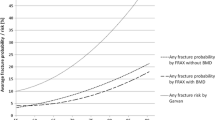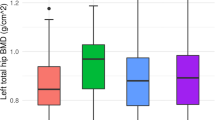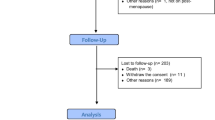Abstract
Distal radius fracture is an early indicator of osteoporosis, yet little is known about men with this fracture and osteoporosis prevalence. The purpose of this cross-sectional, controlled study was to evaluate bone mineral density (BMD) in men, from working age to the elderly, with distal radius fracture. Recruitment was as follows: men who fractured during 1999–2000 were evaluated retrospectively in 2003 and men who fractured during 2003–2007 were followed prospectively for one year post-fracture. A total of 233 patients, response rate 40 %, were enrolled and compared with 643 controls. Fractures from all degrees of trauma were included. BMD was measured at femoral neck, total hip, and lumbar spine. Mean age at fracture was 52 years (21–88 years). Men aged 40–64 years had 5.4–6.7 % lower BMD at all sites compared to controls (p = 0.001) and in >65 years BMD was lower by 10.7–13.8 % (p < 0.001), while not significant at <40 years (1.4–2.8 %; p = 0.228–0.487). Osteoporosis was more prevalent at all ages (20–39 years: 8.5 vs 1.5 %; 40–64 years: 16.8 vs 5.1 %; >65 years: 23.3 vs 8.3 %) BMD did not differ with trauma level. Already from age 40, men with a distal radius fracture had lower BMD, the difference becoming more pronounced with increasing age. Also, the prevalence of osteoporosis was higher, surprisingly even in the youngest age group.


Similar content being viewed by others
References
Cummings SR, Kelsey JL, Nevitt MC, O’Dowd KJ (1985) Epidemiology of osteoporosis and osteoporotic fractures. Epidemiol Rev 7:178–208
Cuddihy MT, Gabriel SE, Crowson CS, O’Fallon WM, Melton LJ 3rd (1999) Forearm fractures as predictors of subsequent osteoporotic fractures. Osteoporos Int 9:469–475
Mallmin H, Ljunghall S, Persson I, Naessén T, Krusemo UB et al (1993) Fracture of the distal forearm as a forecaster of subsequent hip fracture: a population-based cohort study with 24 years of follow-up. Calcif Tissue Int 52:269–272
Nellans KW, Kowalski E, Chung KC (2012) The Epidemiology of distal radius fractures. Hand Clin 28:113–125
Mallmin H, Ljunghall S (1992) Incidence of Colles’ fracture in Uppsala. A prospective study of a quarter-million population. Acta Orthop Scand 63:213–215
Wilcke MKT, Hammarberg H, Adolphson PY (2013) Epidemiology and changed surgical treatment methods for fractures of the distal radius: a registry analysis of 42,583 patients in Stockholm County, Sweden, 2004–2010. Acta Orthop 84:292–296
Haentjens P, Johnell O, Kanis JA, Bouillon R, Cooper C et al (2004) Evidence from data searches and life-table analyses for gender-related differences in absolute risk of hip fracture after Colles’ or spine fracture: Colles’ fracture as an early and sensitive marker of skeletal fragility in white men. J Bone Miner Res 19:1933–1944
Ismail AA, Pye SR, Cockerill WC, Lunt M, Silman AJ et al (2002) Incidence of limb fracture across Europe: results from the European Prospective Osteoporosis Study (EPOS). Osteoporos Int 13:565–571
Cummings SR, Melton LJ (2002) Epidemiology and outcomes of osteoporotic fractures. Lancet 359:1761–1767
Järvinen TLN, Sievänen H, Khan KM, Heinonen A, Kannus P (2008) Shifting the focus in fracture prevention from osteoporosis to falls. BMJ 336:124–126
Tuck SP, Raj N, Summers GD (2002) Is distal forearm fracture in men due to osteoporosis? Osteoporos Int 13:630–636
Lee DM, Pye SR, Tajar A, O’Neill TW, Finn JD et al (2013) Cohort profile: the European Male ageing study. Int J Epidemiol 42:391–401
Callréus M, McGuigan F, Akesson K (2014) Country-specific young adult dual-energy X-ray absorptiometry reference data are warranted for T-score calculations in women: data from the peak-25 cohort. J Clin Densitom 17:129–135
Looker AC, Orwoll ES, Johnston CC, Lindsay RL, Wahner HW et al (1997) Prevalence of low femoral bone density in older U.S. adults from NHANES III. J Bone Miner Res 12:1761–1768
Khosla S, Amin S, Orwoll E (2008) Osteoporosis in men. Endocr Rev 29:441–464
Abrahamsen B, van Staa T, Ariely R, Olson M, Cooper C (2009) Excess mortality following hip fracture: a systematic epidemiological review. Osteoporos Int 20:1633–1650
Øyen J, Rohde G, Hochberg M, Johnsen V, Haugeberg G (2011) Low bone mineral density is a significant risk factor for low-energy distal radius fractures in middle-aged and elderly men: a case-control study. BMC Musculoskelet Disord 12:67
Risto O, Hammar E, Hammar K, Fredrikson M, Hammar M et al (2012) Elderly men with a history of distal radius fracture have significantly lower calcaneal bone density and free androgen index than age-matched controls. Aging Male 15:59–62
Sharma S, Fraser M, Lovell F, Reece A, McLellan AR (2008) Characteristics of males over 50 years who present with a fracture: epidemiology and underlying risk factors. J Bone Joint Surg Br 90:72–77
Øyen J, Gjesdal CG, Brudvik C, Hove LM, Apalset EM et al (2010) Low-energy distal radius fractures in middle-aged and elderly men and women–the burden of osteoporosis and fracture risk: a study of 1794 consecutive patients. Osteoporos Int 21:1257–1267
Oyen J, Brudvik C, Gjesdal CG, Tell GS, Lie SA et al (2011) Osteoporosis as a risk factor for distal radial fractures: a case-control study. J Bone Joint Surg Am 93:348–356
Lindau TR, Aspenberg P, Arner M, Redlundh-Johnell I, Hagberg L (1999) Fractures of the distal forearm in young adults. An epidemiologic description of 341 patients. Acta Orthop Scand 70:124–128
Szulc P, Munoz F, Duboeuf F, Marchand F, Delmas PD (2006) Low width of tubular bones is associated with increased risk of fragility fracture in elderly men—the MINOS study. Bone 38:595–602
Kiebzak GM, Beinart GA, Perser K, Ambrose CG, Siff SJ et al (2002) Undertreatment of osteoporosis in men with hip fracture. Arch Intern Med 162:2217–2222
Harper CM, Fitzpatrick SK, Zurakowski D, Rozental TD (2014) Distal radial fractures in older men: a missed opportunity? J Bone Joint Surg Am 96:1820–1827
Acknowledgments
This work was supported by grants from the Swedish Research Council (K2012-52X-14691-10-3), FAS (2007-2125), Greta and Johan Kock Foundation, A. Påhlsson Foundation, A. Osterlund Foundation, the H Järnhardt foundation, King Gustav V and Queen Victoria Foundation, The Swedish Rheumatism Association, Skåne University Hospital Research Fund, Research and Development Council of Region Skåne, Sweden; Commission of the European Communities Fifth Framework Programme ‘Quality of Life and Management of Living Resources’ Grant QLK6-CT-2001-00258.
Author’s Contribution
Lisa Egund and Fiona McGuigan were responsible for the statistical analysis and interpretation of data and Lisa Egund prepared the first draft of this paper. Karin Önnby designed the study and with Aleksander Giwercman was responsible for the acquisition of data. Kristina Akesson designed the study and is guarantor. All authors revised the paper critically for intellectual content and approved the final version. All authors agree to be accountable for the work and to ensure that any questions relating to the accuracy and integrity of the paper are investigated and properly resolved.
Funding
The funders had no role in study design, data collection and analysis, decision to publish, or preparation of the manuscript.
Author information
Authors and Affiliations
Corresponding author
Ethics declarations
Conflict of interest
Lisa Egund, Fiona McGuigan, Karin Önnby, Aleksander Giwercman, and Kristina Akesson declare that they have no conflict of interest.
Human and animal rights statements
All procedures performed in this study involving human participants were in concordance with the ethical standards of the institutional research committee and with the 1964 Helsinki declaration and its later amendments or comparable ethical standards.
Informed consent
Informed consent was obtained from all individual participants included in the study.
Electronic supplementary material
Below is the link to the electronic supplementary material.
Rights and permissions
About this article
Cite this article
Egund, L., McGuigan, F., Önnby, K. et al. High Prevalence of Osteoporosis in Men with Distal Radius Fracture: A Cross-Sectional Study of 233 Men. Calcif Tissue Int 99, 250–258 (2016). https://doi.org/10.1007/s00223-016-0142-6
Received:
Accepted:
Published:
Issue Date:
DOI: https://doi.org/10.1007/s00223-016-0142-6




